Health Care - Pathogenesis in Relation to the Case study
VerifiedAdded on 2022/08/20
|7
|2148
|9
AI Summary
Contribute Materials
Your contribution can guide someone’s learning journey. Share your
documents today.

Running head: HEALTH CARE
Health care
Name of the student:
Name of the University:
Author’s note
Health care
Name of the student:
Name of the University:
Author’s note
Secure Best Marks with AI Grader
Need help grading? Try our AI Grader for instant feedback on your assignments.
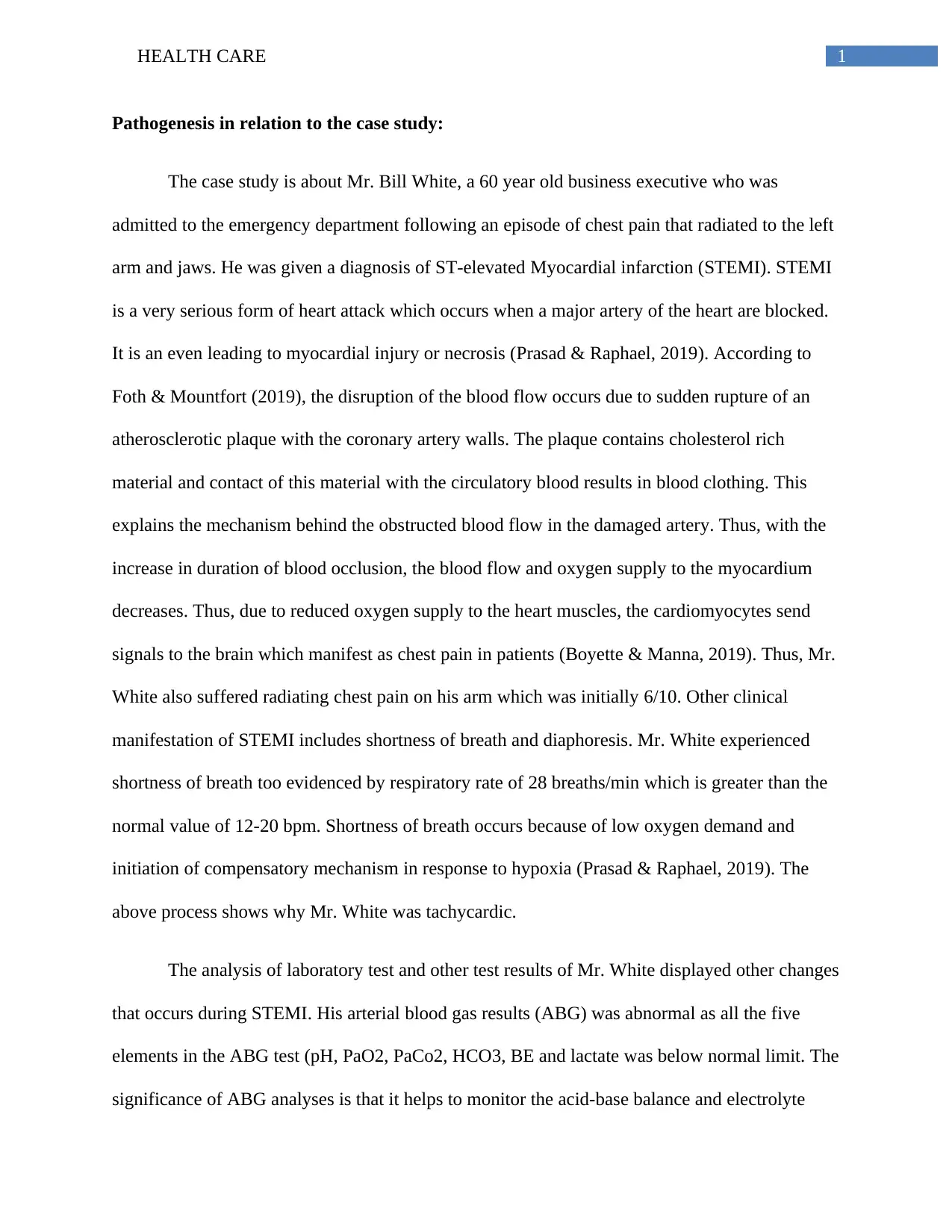
1HEALTH CARE
Pathogenesis in relation to the case study:
The case study is about Mr. Bill White, a 60 year old business executive who was
admitted to the emergency department following an episode of chest pain that radiated to the left
arm and jaws. He was given a diagnosis of ST-elevated Myocardial infarction (STEMI). STEMI
is a very serious form of heart attack which occurs when a major artery of the heart are blocked.
It is an even leading to myocardial injury or necrosis (Prasad & Raphael, 2019). According to
Foth & Mountfort (2019), the disruption of the blood flow occurs due to sudden rupture of an
atherosclerotic plaque with the coronary artery walls. The plaque contains cholesterol rich
material and contact of this material with the circulatory blood results in blood clothing. This
explains the mechanism behind the obstructed blood flow in the damaged artery. Thus, with the
increase in duration of blood occlusion, the blood flow and oxygen supply to the myocardium
decreases. Thus, due to reduced oxygen supply to the heart muscles, the cardiomyocytes send
signals to the brain which manifest as chest pain in patients (Boyette & Manna, 2019). Thus, Mr.
White also suffered radiating chest pain on his arm which was initially 6/10. Other clinical
manifestation of STEMI includes shortness of breath and diaphoresis. Mr. White experienced
shortness of breath too evidenced by respiratory rate of 28 breaths/min which is greater than the
normal value of 12-20 bpm. Shortness of breath occurs because of low oxygen demand and
initiation of compensatory mechanism in response to hypoxia (Prasad & Raphael, 2019). The
above process shows why Mr. White was tachycardic.
The analysis of laboratory test and other test results of Mr. White displayed other changes
that occurs during STEMI. His arterial blood gas results (ABG) was abnormal as all the five
elements in the ABG test (pH, PaO2, PaCo2, HCO3, BE and lactate was below normal limit. The
significance of ABG analyses is that it helps to monitor the acid-base balance and electrolyte
Pathogenesis in relation to the case study:
The case study is about Mr. Bill White, a 60 year old business executive who was
admitted to the emergency department following an episode of chest pain that radiated to the left
arm and jaws. He was given a diagnosis of ST-elevated Myocardial infarction (STEMI). STEMI
is a very serious form of heart attack which occurs when a major artery of the heart are blocked.
It is an even leading to myocardial injury or necrosis (Prasad & Raphael, 2019). According to
Foth & Mountfort (2019), the disruption of the blood flow occurs due to sudden rupture of an
atherosclerotic plaque with the coronary artery walls. The plaque contains cholesterol rich
material and contact of this material with the circulatory blood results in blood clothing. This
explains the mechanism behind the obstructed blood flow in the damaged artery. Thus, with the
increase in duration of blood occlusion, the blood flow and oxygen supply to the myocardium
decreases. Thus, due to reduced oxygen supply to the heart muscles, the cardiomyocytes send
signals to the brain which manifest as chest pain in patients (Boyette & Manna, 2019). Thus, Mr.
White also suffered radiating chest pain on his arm which was initially 6/10. Other clinical
manifestation of STEMI includes shortness of breath and diaphoresis. Mr. White experienced
shortness of breath too evidenced by respiratory rate of 28 breaths/min which is greater than the
normal value of 12-20 bpm. Shortness of breath occurs because of low oxygen demand and
initiation of compensatory mechanism in response to hypoxia (Prasad & Raphael, 2019). The
above process shows why Mr. White was tachycardic.
The analysis of laboratory test and other test results of Mr. White displayed other changes
that occurs during STEMI. His arterial blood gas results (ABG) was abnormal as all the five
elements in the ABG test (pH, PaO2, PaCo2, HCO3, BE and lactate was below normal limit. The
significance of ABG analyses is that it helps to monitor the acid-base balance and electrolyte
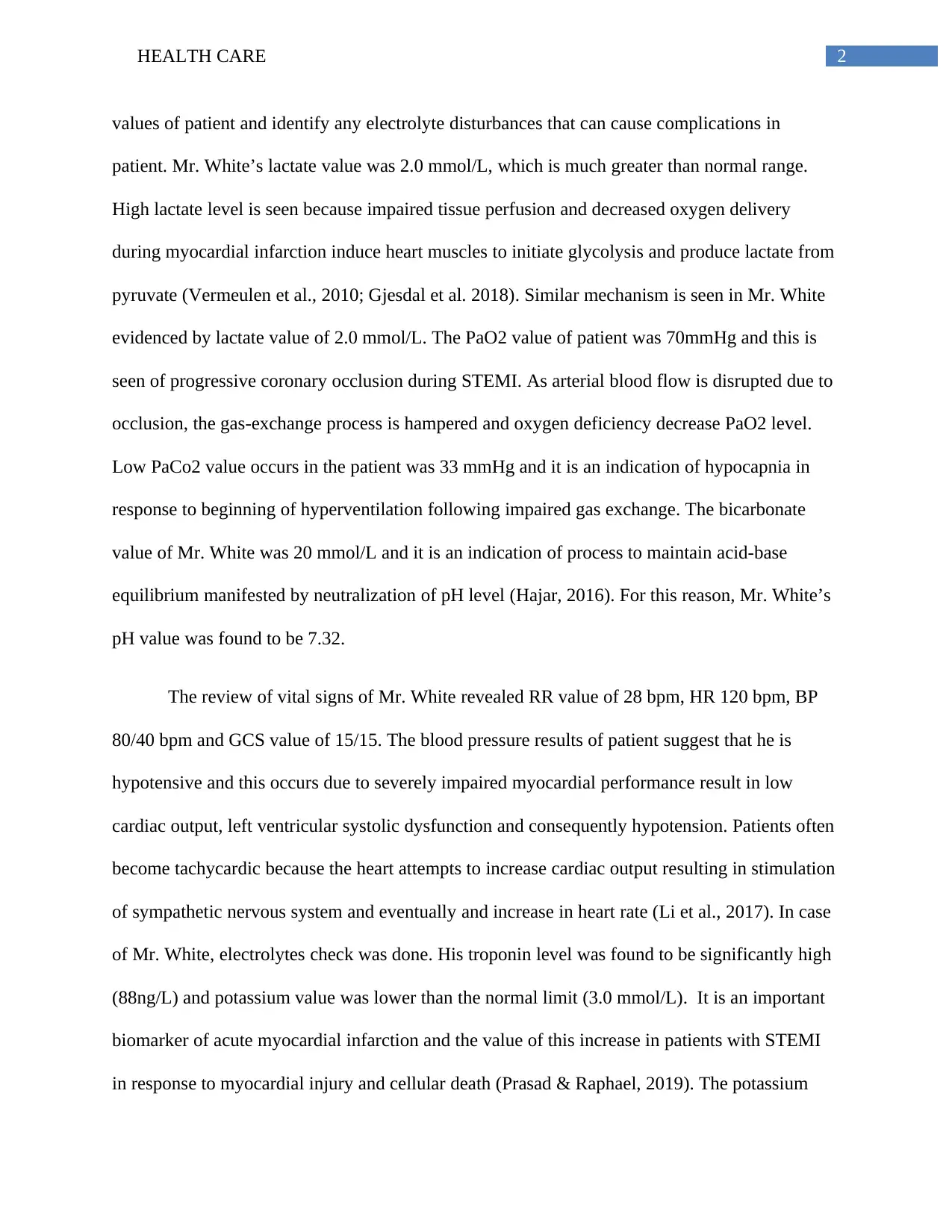
2HEALTH CARE
values of patient and identify any electrolyte disturbances that can cause complications in
patient. Mr. White’s lactate value was 2.0 mmol/L, which is much greater than normal range.
High lactate level is seen because impaired tissue perfusion and decreased oxygen delivery
during myocardial infarction induce heart muscles to initiate glycolysis and produce lactate from
pyruvate (Vermeulen et al., 2010; Gjesdal et al. 2018). Similar mechanism is seen in Mr. White
evidenced by lactate value of 2.0 mmol/L. The PaO2 value of patient was 70mmHg and this is
seen of progressive coronary occlusion during STEMI. As arterial blood flow is disrupted due to
occlusion, the gas-exchange process is hampered and oxygen deficiency decrease PaO2 level.
Low PaCo2 value occurs in the patient was 33 mmHg and it is an indication of hypocapnia in
response to beginning of hyperventilation following impaired gas exchange. The bicarbonate
value of Mr. White was 20 mmol/L and it is an indication of process to maintain acid-base
equilibrium manifested by neutralization of pH level (Hajar, 2016). For this reason, Mr. White’s
pH value was found to be 7.32.
The review of vital signs of Mr. White revealed RR value of 28 bpm, HR 120 bpm, BP
80/40 bpm and GCS value of 15/15. The blood pressure results of patient suggest that he is
hypotensive and this occurs due to severely impaired myocardial performance result in low
cardiac output, left ventricular systolic dysfunction and consequently hypotension. Patients often
become tachycardic because the heart attempts to increase cardiac output resulting in stimulation
of sympathetic nervous system and eventually and increase in heart rate (Li et al., 2017). In case
of Mr. White, electrolytes check was done. His troponin level was found to be significantly high
(88ng/L) and potassium value was lower than the normal limit (3.0 mmol/L). It is an important
biomarker of acute myocardial infarction and the value of this increase in patients with STEMI
in response to myocardial injury and cellular death (Prasad & Raphael, 2019). The potassium
values of patient and identify any electrolyte disturbances that can cause complications in
patient. Mr. White’s lactate value was 2.0 mmol/L, which is much greater than normal range.
High lactate level is seen because impaired tissue perfusion and decreased oxygen delivery
during myocardial infarction induce heart muscles to initiate glycolysis and produce lactate from
pyruvate (Vermeulen et al., 2010; Gjesdal et al. 2018). Similar mechanism is seen in Mr. White
evidenced by lactate value of 2.0 mmol/L. The PaO2 value of patient was 70mmHg and this is
seen of progressive coronary occlusion during STEMI. As arterial blood flow is disrupted due to
occlusion, the gas-exchange process is hampered and oxygen deficiency decrease PaO2 level.
Low PaCo2 value occurs in the patient was 33 mmHg and it is an indication of hypocapnia in
response to beginning of hyperventilation following impaired gas exchange. The bicarbonate
value of Mr. White was 20 mmol/L and it is an indication of process to maintain acid-base
equilibrium manifested by neutralization of pH level (Hajar, 2016). For this reason, Mr. White’s
pH value was found to be 7.32.
The review of vital signs of Mr. White revealed RR value of 28 bpm, HR 120 bpm, BP
80/40 bpm and GCS value of 15/15. The blood pressure results of patient suggest that he is
hypotensive and this occurs due to severely impaired myocardial performance result in low
cardiac output, left ventricular systolic dysfunction and consequently hypotension. Patients often
become tachycardic because the heart attempts to increase cardiac output resulting in stimulation
of sympathetic nervous system and eventually and increase in heart rate (Li et al., 2017). In case
of Mr. White, electrolytes check was done. His troponin level was found to be significantly high
(88ng/L) and potassium value was lower than the normal limit (3.0 mmol/L). It is an important
biomarker of acute myocardial infarction and the value of this increase in patients with STEMI
in response to myocardial injury and cellular death (Prasad & Raphael, 2019). The potassium
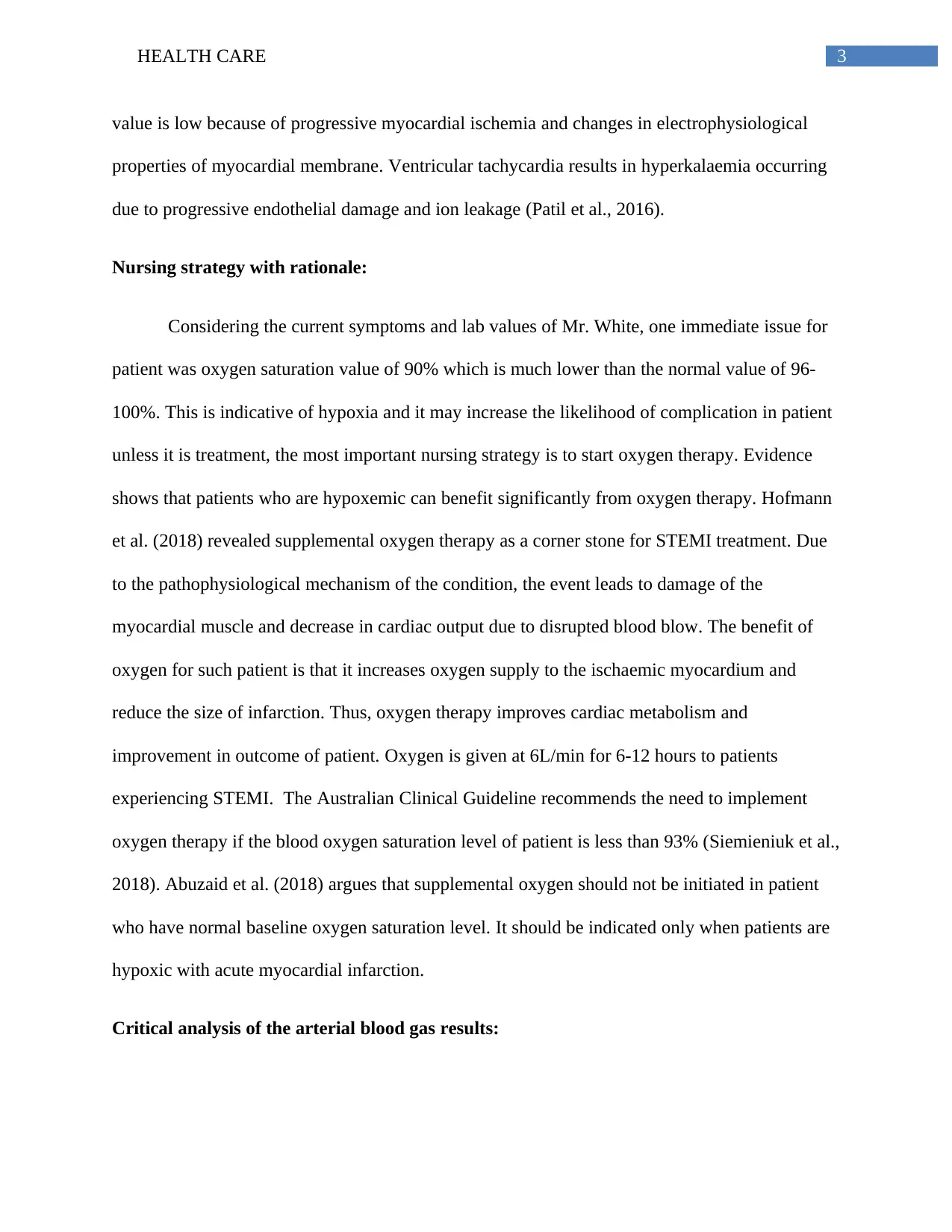
3HEALTH CARE
value is low because of progressive myocardial ischemia and changes in electrophysiological
properties of myocardial membrane. Ventricular tachycardia results in hyperkalaemia occurring
due to progressive endothelial damage and ion leakage (Patil et al., 2016).
Nursing strategy with rationale:
Considering the current symptoms and lab values of Mr. White, one immediate issue for
patient was oxygen saturation value of 90% which is much lower than the normal value of 96-
100%. This is indicative of hypoxia and it may increase the likelihood of complication in patient
unless it is treatment, the most important nursing strategy is to start oxygen therapy. Evidence
shows that patients who are hypoxemic can benefit significantly from oxygen therapy. Hofmann
et al. (2018) revealed supplemental oxygen therapy as a corner stone for STEMI treatment. Due
to the pathophysiological mechanism of the condition, the event leads to damage of the
myocardial muscle and decrease in cardiac output due to disrupted blood blow. The benefit of
oxygen for such patient is that it increases oxygen supply to the ischaemic myocardium and
reduce the size of infarction. Thus, oxygen therapy improves cardiac metabolism and
improvement in outcome of patient. Oxygen is given at 6L/min for 6-12 hours to patients
experiencing STEMI. The Australian Clinical Guideline recommends the need to implement
oxygen therapy if the blood oxygen saturation level of patient is less than 93% (Siemieniuk et al.,
2018). Abuzaid et al. (2018) argues that supplemental oxygen should not be initiated in patient
who have normal baseline oxygen saturation level. It should be indicated only when patients are
hypoxic with acute myocardial infarction.
Critical analysis of the arterial blood gas results:
value is low because of progressive myocardial ischemia and changes in electrophysiological
properties of myocardial membrane. Ventricular tachycardia results in hyperkalaemia occurring
due to progressive endothelial damage and ion leakage (Patil et al., 2016).
Nursing strategy with rationale:
Considering the current symptoms and lab values of Mr. White, one immediate issue for
patient was oxygen saturation value of 90% which is much lower than the normal value of 96-
100%. This is indicative of hypoxia and it may increase the likelihood of complication in patient
unless it is treatment, the most important nursing strategy is to start oxygen therapy. Evidence
shows that patients who are hypoxemic can benefit significantly from oxygen therapy. Hofmann
et al. (2018) revealed supplemental oxygen therapy as a corner stone for STEMI treatment. Due
to the pathophysiological mechanism of the condition, the event leads to damage of the
myocardial muscle and decrease in cardiac output due to disrupted blood blow. The benefit of
oxygen for such patient is that it increases oxygen supply to the ischaemic myocardium and
reduce the size of infarction. Thus, oxygen therapy improves cardiac metabolism and
improvement in outcome of patient. Oxygen is given at 6L/min for 6-12 hours to patients
experiencing STEMI. The Australian Clinical Guideline recommends the need to implement
oxygen therapy if the blood oxygen saturation level of patient is less than 93% (Siemieniuk et al.,
2018). Abuzaid et al. (2018) argues that supplemental oxygen should not be initiated in patient
who have normal baseline oxygen saturation level. It should be indicated only when patients are
hypoxic with acute myocardial infarction.
Critical analysis of the arterial blood gas results:
Secure Best Marks with AI Grader
Need help grading? Try our AI Grader for instant feedback on your assignments.
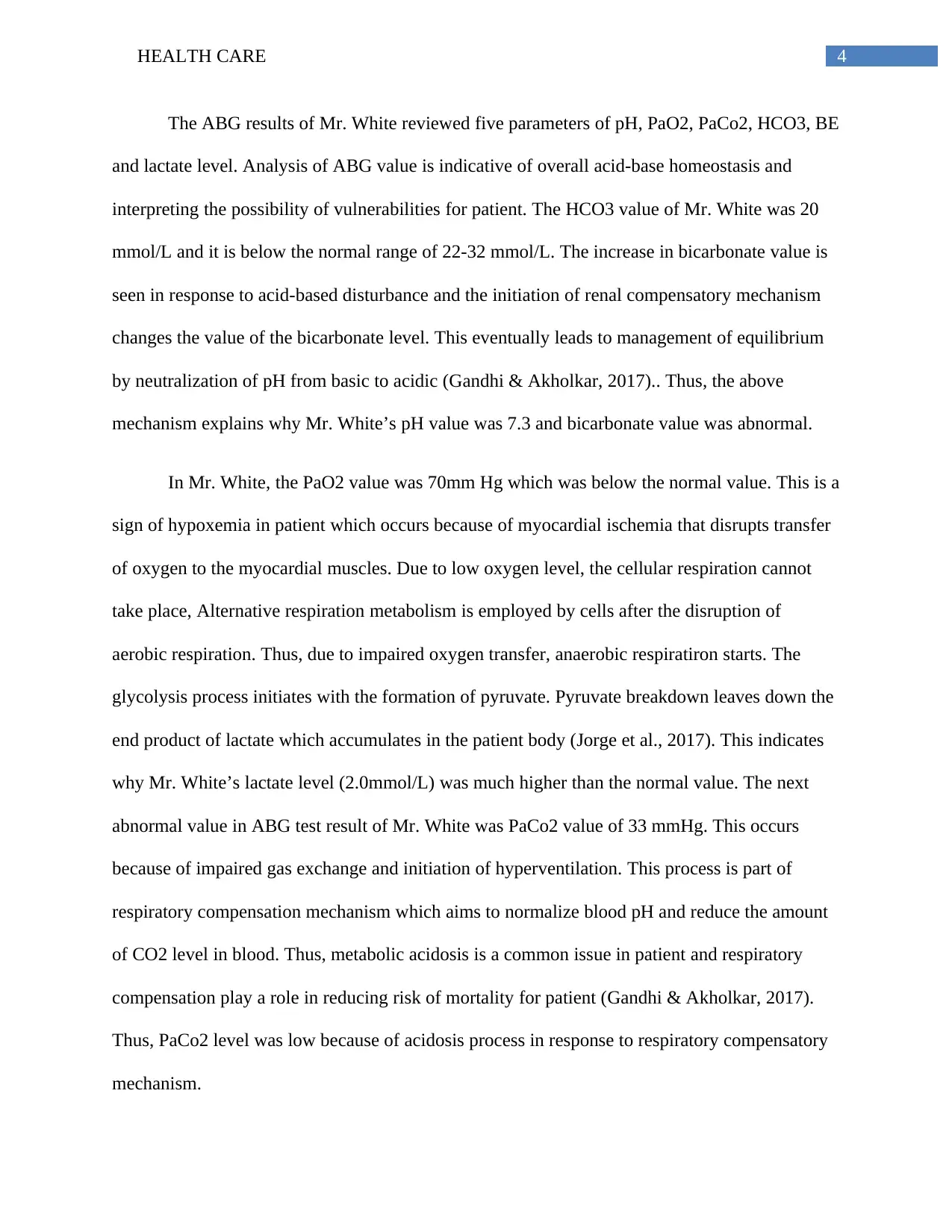
4HEALTH CARE
The ABG results of Mr. White reviewed five parameters of pH, PaO2, PaCo2, HCO3, BE
and lactate level. Analysis of ABG value is indicative of overall acid-base homeostasis and
interpreting the possibility of vulnerabilities for patient. The HCO3 value of Mr. White was 20
mmol/L and it is below the normal range of 22-32 mmol/L. The increase in bicarbonate value is
seen in response to acid-based disturbance and the initiation of renal compensatory mechanism
changes the value of the bicarbonate level. This eventually leads to management of equilibrium
by neutralization of pH from basic to acidic (Gandhi & Akholkar, 2017).. Thus, the above
mechanism explains why Mr. White’s pH value was 7.3 and bicarbonate value was abnormal.
In Mr. White, the PaO2 value was 70mm Hg which was below the normal value. This is a
sign of hypoxemia in patient which occurs because of myocardial ischemia that disrupts transfer
of oxygen to the myocardial muscles. Due to low oxygen level, the cellular respiration cannot
take place, Alternative respiration metabolism is employed by cells after the disruption of
aerobic respiration. Thus, due to impaired oxygen transfer, anaerobic respiratiron starts. The
glycolysis process initiates with the formation of pyruvate. Pyruvate breakdown leaves down the
end product of lactate which accumulates in the patient body (Jorge et al., 2017). This indicates
why Mr. White’s lactate level (2.0mmol/L) was much higher than the normal value. The next
abnormal value in ABG test result of Mr. White was PaCo2 value of 33 mmHg. This occurs
because of impaired gas exchange and initiation of hyperventilation. This process is part of
respiratory compensation mechanism which aims to normalize blood pH and reduce the amount
of CO2 level in blood. Thus, metabolic acidosis is a common issue in patient and respiratory
compensation play a role in reducing risk of mortality for patient (Gandhi & Akholkar, 2017).
Thus, PaCo2 level was low because of acidosis process in response to respiratory compensatory
mechanism.
The ABG results of Mr. White reviewed five parameters of pH, PaO2, PaCo2, HCO3, BE
and lactate level. Analysis of ABG value is indicative of overall acid-base homeostasis and
interpreting the possibility of vulnerabilities for patient. The HCO3 value of Mr. White was 20
mmol/L and it is below the normal range of 22-32 mmol/L. The increase in bicarbonate value is
seen in response to acid-based disturbance and the initiation of renal compensatory mechanism
changes the value of the bicarbonate level. This eventually leads to management of equilibrium
by neutralization of pH from basic to acidic (Gandhi & Akholkar, 2017).. Thus, the above
mechanism explains why Mr. White’s pH value was 7.3 and bicarbonate value was abnormal.
In Mr. White, the PaO2 value was 70mm Hg which was below the normal value. This is a
sign of hypoxemia in patient which occurs because of myocardial ischemia that disrupts transfer
of oxygen to the myocardial muscles. Due to low oxygen level, the cellular respiration cannot
take place, Alternative respiration metabolism is employed by cells after the disruption of
aerobic respiration. Thus, due to impaired oxygen transfer, anaerobic respiratiron starts. The
glycolysis process initiates with the formation of pyruvate. Pyruvate breakdown leaves down the
end product of lactate which accumulates in the patient body (Jorge et al., 2017). This indicates
why Mr. White’s lactate level (2.0mmol/L) was much higher than the normal value. The next
abnormal value in ABG test result of Mr. White was PaCo2 value of 33 mmHg. This occurs
because of impaired gas exchange and initiation of hyperventilation. This process is part of
respiratory compensation mechanism which aims to normalize blood pH and reduce the amount
of CO2 level in blood. Thus, metabolic acidosis is a common issue in patient and respiratory
compensation play a role in reducing risk of mortality for patient (Gandhi & Akholkar, 2017).
Thus, PaCo2 level was low because of acidosis process in response to respiratory compensatory
mechanism.
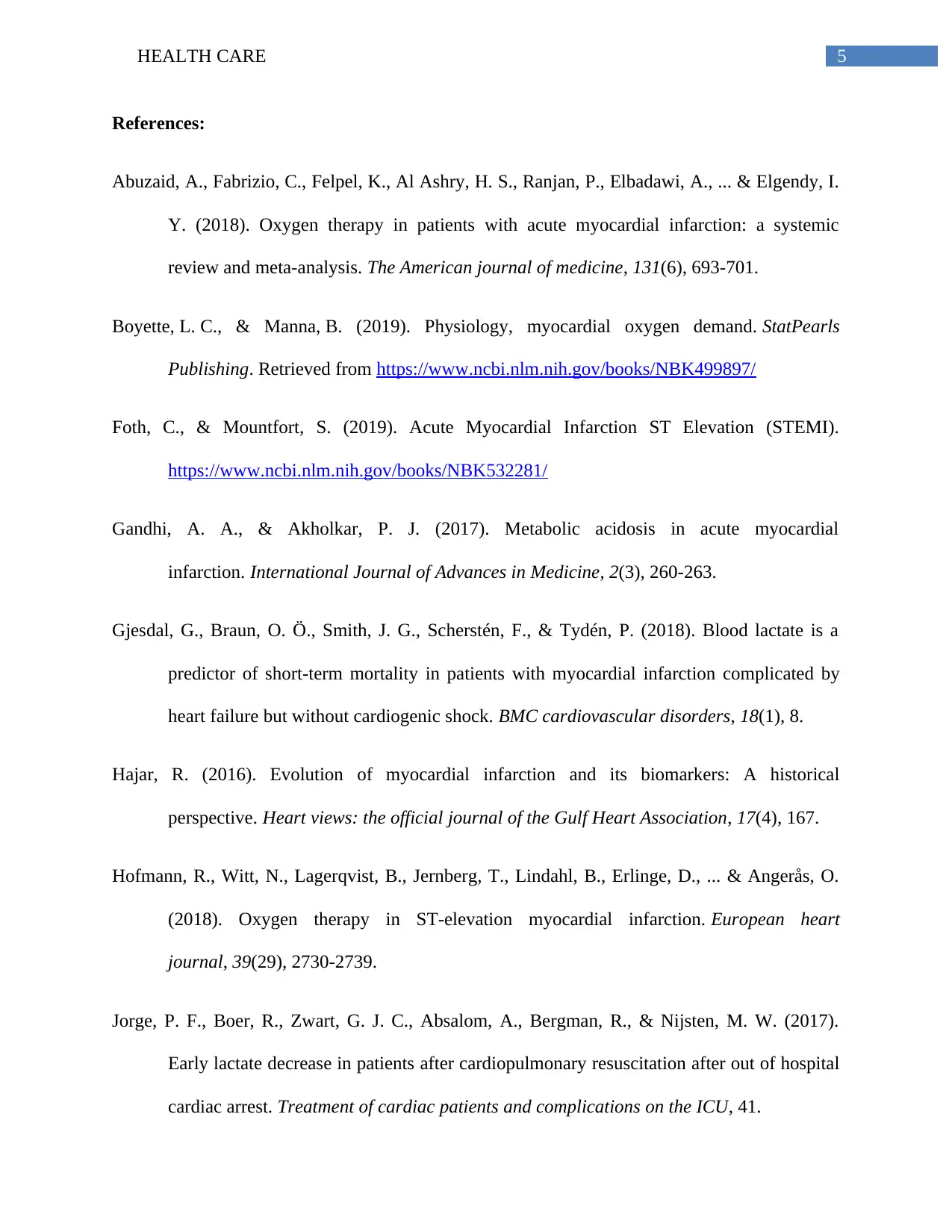
5HEALTH CARE
References:
Abuzaid, A., Fabrizio, C., Felpel, K., Al Ashry, H. S., Ranjan, P., Elbadawi, A., ... & Elgendy, I.
Y. (2018). Oxygen therapy in patients with acute myocardial infarction: a systemic
review and meta-analysis. The American journal of medicine, 131(6), 693-701.
Boyette, L. C., & Manna, B. (2019). Physiology, myocardial oxygen demand. StatPearls
Publishing. Retrieved from https://www.ncbi.nlm.nih.gov/books/NBK499897/
Foth, C., & Mountfort, S. (2019). Acute Myocardial Infarction ST Elevation (STEMI).
https://www.ncbi.nlm.nih.gov/books/NBK532281/
Gandhi, A. A., & Akholkar, P. J. (2017). Metabolic acidosis in acute myocardial
infarction. International Journal of Advances in Medicine, 2(3), 260-263.
Gjesdal, G., Braun, O. Ö., Smith, J. G., Scherstén, F., & Tydén, P. (2018). Blood lactate is a
predictor of short-term mortality in patients with myocardial infarction complicated by
heart failure but without cardiogenic shock. BMC cardiovascular disorders, 18(1), 8.
Hajar, R. (2016). Evolution of myocardial infarction and its biomarkers: A historical
perspective. Heart views: the official journal of the Gulf Heart Association, 17(4), 167.
Hofmann, R., Witt, N., Lagerqvist, B., Jernberg, T., Lindahl, B., Erlinge, D., ... & Angerås, O.
(2018). Oxygen therapy in ST-elevation myocardial infarction. European heart
journal, 39(29), 2730-2739.
Jorge, P. F., Boer, R., Zwart, G. J. C., Absalom, A., Bergman, R., & Nijsten, M. W. (2017).
Early lactate decrease in patients after cardiopulmonary resuscitation after out of hospital
cardiac arrest. Treatment of cardiac patients and complications on the ICU, 41.
References:
Abuzaid, A., Fabrizio, C., Felpel, K., Al Ashry, H. S., Ranjan, P., Elbadawi, A., ... & Elgendy, I.
Y. (2018). Oxygen therapy in patients with acute myocardial infarction: a systemic
review and meta-analysis. The American journal of medicine, 131(6), 693-701.
Boyette, L. C., & Manna, B. (2019). Physiology, myocardial oxygen demand. StatPearls
Publishing. Retrieved from https://www.ncbi.nlm.nih.gov/books/NBK499897/
Foth, C., & Mountfort, S. (2019). Acute Myocardial Infarction ST Elevation (STEMI).
https://www.ncbi.nlm.nih.gov/books/NBK532281/
Gandhi, A. A., & Akholkar, P. J. (2017). Metabolic acidosis in acute myocardial
infarction. International Journal of Advances in Medicine, 2(3), 260-263.
Gjesdal, G., Braun, O. Ö., Smith, J. G., Scherstén, F., & Tydén, P. (2018). Blood lactate is a
predictor of short-term mortality in patients with myocardial infarction complicated by
heart failure but without cardiogenic shock. BMC cardiovascular disorders, 18(1), 8.
Hajar, R. (2016). Evolution of myocardial infarction and its biomarkers: A historical
perspective. Heart views: the official journal of the Gulf Heart Association, 17(4), 167.
Hofmann, R., Witt, N., Lagerqvist, B., Jernberg, T., Lindahl, B., Erlinge, D., ... & Angerås, O.
(2018). Oxygen therapy in ST-elevation myocardial infarction. European heart
journal, 39(29), 2730-2739.
Jorge, P. F., Boer, R., Zwart, G. J. C., Absalom, A., Bergman, R., & Nijsten, M. W. (2017).
Early lactate decrease in patients after cardiopulmonary resuscitation after out of hospital
cardiac arrest. Treatment of cardiac patients and complications on the ICU, 41.
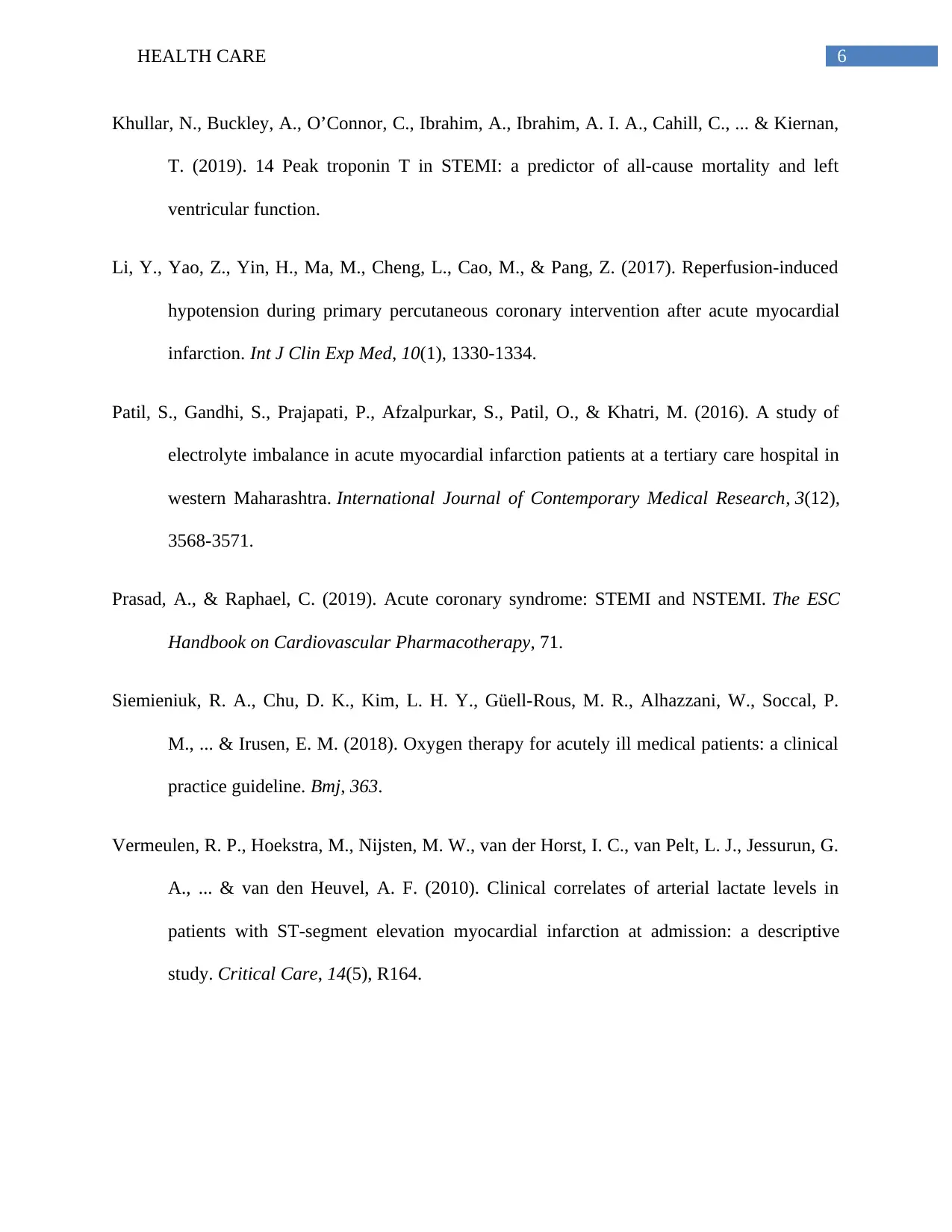
6HEALTH CARE
Khullar, N., Buckley, A., O’Connor, C., Ibrahim, A., Ibrahim, A. I. A., Cahill, C., ... & Kiernan,
T. (2019). 14 Peak troponin T in STEMI: a predictor of all-cause mortality and left
ventricular function.
Li, Y., Yao, Z., Yin, H., Ma, M., Cheng, L., Cao, M., & Pang, Z. (2017). Reperfusion-induced
hypotension during primary percutaneous coronary intervention after acute myocardial
infarction. Int J Clin Exp Med, 10(1), 1330-1334.
Patil, S., Gandhi, S., Prajapati, P., Afzalpurkar, S., Patil, O., & Khatri, M. (2016). A study of
electrolyte imbalance in acute myocardial infarction patients at a tertiary care hospital in
western Maharashtra. International Journal of Contemporary Medical Research, 3(12),
3568-3571.
Prasad, A., & Raphael, C. (2019). Acute coronary syndrome: STEMI and NSTEMI. The ESC
Handbook on Cardiovascular Pharmacotherapy, 71.
Siemieniuk, R. A., Chu, D. K., Kim, L. H. Y., Güell-Rous, M. R., Alhazzani, W., Soccal, P.
M., ... & Irusen, E. M. (2018). Oxygen therapy for acutely ill medical patients: a clinical
practice guideline. Bmj, 363.
Vermeulen, R. P., Hoekstra, M., Nijsten, M. W., van der Horst, I. C., van Pelt, L. J., Jessurun, G.
A., ... & van den Heuvel, A. F. (2010). Clinical correlates of arterial lactate levels in
patients with ST-segment elevation myocardial infarction at admission: a descriptive
study. Critical Care, 14(5), R164.
Khullar, N., Buckley, A., O’Connor, C., Ibrahim, A., Ibrahim, A. I. A., Cahill, C., ... & Kiernan,
T. (2019). 14 Peak troponin T in STEMI: a predictor of all-cause mortality and left
ventricular function.
Li, Y., Yao, Z., Yin, H., Ma, M., Cheng, L., Cao, M., & Pang, Z. (2017). Reperfusion-induced
hypotension during primary percutaneous coronary intervention after acute myocardial
infarction. Int J Clin Exp Med, 10(1), 1330-1334.
Patil, S., Gandhi, S., Prajapati, P., Afzalpurkar, S., Patil, O., & Khatri, M. (2016). A study of
electrolyte imbalance in acute myocardial infarction patients at a tertiary care hospital in
western Maharashtra. International Journal of Contemporary Medical Research, 3(12),
3568-3571.
Prasad, A., & Raphael, C. (2019). Acute coronary syndrome: STEMI and NSTEMI. The ESC
Handbook on Cardiovascular Pharmacotherapy, 71.
Siemieniuk, R. A., Chu, D. K., Kim, L. H. Y., Güell-Rous, M. R., Alhazzani, W., Soccal, P.
M., ... & Irusen, E. M. (2018). Oxygen therapy for acutely ill medical patients: a clinical
practice guideline. Bmj, 363.
Vermeulen, R. P., Hoekstra, M., Nijsten, M. W., van der Horst, I. C., van Pelt, L. J., Jessurun, G.
A., ... & van den Heuvel, A. F. (2010). Clinical correlates of arterial lactate levels in
patients with ST-segment elevation myocardial infarction at admission: a descriptive
study. Critical Care, 14(5), R164.
1 out of 7
Related Documents
Your All-in-One AI-Powered Toolkit for Academic Success.
+13062052269
info@desklib.com
Available 24*7 on WhatsApp / Email
![[object Object]](/_next/static/media/star-bottom.7253800d.svg)
Unlock your academic potential
© 2024 | Zucol Services PVT LTD | All rights reserved.




